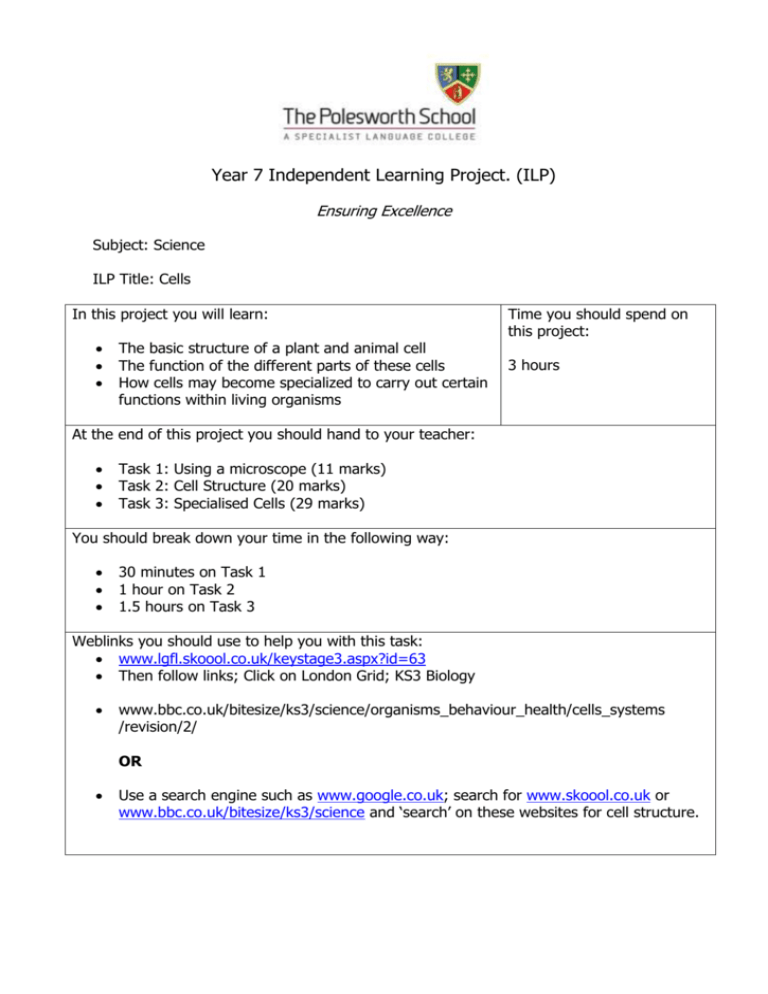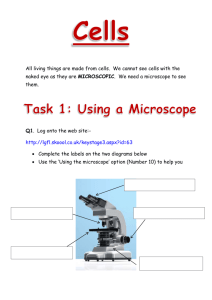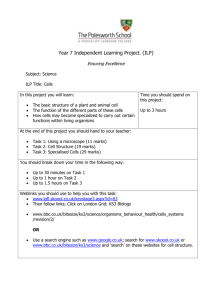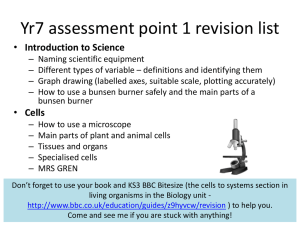Year 7 Science: Cells ILP - Structure, Function, Specialization
advertisement

Year 7 Independent Learning Project. (ILP) Ensuring Excellence Subject: Science ILP Title: Cells In this project you will learn: The basic structure of a plant and animal cell The function of the different parts of these cells How cells may become specialized to carry out certain functions within living organisms Time you should spend on this project: 3 hours At the end of this project you should hand to your teacher: Task 1: Using a microscope (11 marks) Task 2: Cell Structure (20 marks) Task 3: Specialised Cells (29 marks) You should break down your time in the following way: 30 minutes on Task 1 1 hour on Task 2 1.5 hours on Task 3 Weblinks you should use to help you with this task: www.lgfl.skoool.co.uk/keystage3.aspx?id=63 Then follow links; Click on London Grid; KS3 Biology www.bbc.co.uk/bitesize/ks3/science/organisms_behaviour_health/cells_systems /revision/2/ OR Use a search engine such as www.google.co.uk; search for www.skoool.co.uk or www.bbc.co.uk/bitesize/ks3/science and ‘search’ on these websites for cell structure. Your parents may be able to help you by: Looking at your work in the booklet and checking you have completed all the tasks. Helping you to use the internet to find scientific definitions of key words. Helping you to use these key words to answer the questions in the booklet. If you need extra help the SEN department has additional sheets that may be completed and attached to your booklet. Your work will be assessed by: A total mark /60 will be awarded. The key words to learn in this project are: Nucleus Cytoplasm Vacuole Cell membrane Cell wall Chloroplast Microscope Scale Cell Specialisation Blood Cell Root hair cell Nerve Cell Palisade Cell All living things are made from cells. We cannot see cells with the naked eye as they are MICROSCOPIC. We need a microscope to see them. Log onto the web site:http://lgfl.skoool.co.uk/keystage3.aspx?id=63 Complete the labels on the two diagrams below Use the ‘Using a microscope’ option (Number 10) to help you You would put your specimen onto one of these to place onto the stage of the microscope… You may see these down the microscope… (7 marks) Click on ‘Review’ and read the information Then click on ‘Test’ Answer the two questions Then circle the correct answers:- Q1. A B C Q2. A B C (2 marks) Q3. Microscopes can MAGNIFY the image you can see. Does magnify mean to make an object bigger or smaller? (1 mark) Q4. A microscope that allows you to see MORE DETAIL is said to give more RESOLUTION. Which of the following two pictures, A or B, provides the greater degree of resolution? A (1 mark) B Cells contain structures that have different jobs to help the cell carry out its function. Log onto:www.bbc.co.uk/bitesize/ks3/science/organisms_behaviour_health/c ells_systems/revision/2/ Read through page 2 on Cells. You will see pictures here of what real plant and animal cells look like down a microscope. Read through page 3. You will see here diagrams of how plant and animal cells are drawn in science books. Q5. Draw and label a diagram of each cell below:- (10 marks) Task 2 continued Research the answers to the following questions Find these answers in the wordsearch on the next page:- Q6. What structure controls which substances enter and leave cells? Q7. Where do most chemical reactions occur? Q8. Where is most of the genetic information found? Q9. What structures, only found in plant cells, allow a plant to make glucose by photosynthesis? Q10. What is found in the nucleus that may also be worn on ‘out of school uniform days’? Q11. What green pigment allows a plant to absorb light energy? Q12. What substance is found inside the vacuole? Q13. What substance in plant cells walls, is tough and offers plant cells more support? Q14. What is found outside a plant cell membrane to offer support to plants? Q15. What structure inside plant cells offers extra support and keeps them firm? (10 marks) A specialised cell is a cell with SPECIAL FEATURES to help it carry out a particular function in a living organism. Task 3 Log onto:www.bbc.co.uk/bitesize/ks3/science/organisms_behaviour_health/c ells_systems/revision/4/ (This is the same as page 4 from the previous website you used). Read the information on page 4 and answer the following four questions:- Q16. What does multicellular mean? (1 mark) Q17. What is a specialised cell? (1 mark) Q18. Draw lines to match up the correct picture with the correct type of cell. Draw more lines to match picture of cell to its correct function. (12 marks) Absorbs water and anchors the plant in Palisade Cell the soil Swims to fertilise the egg Egg cell Absorbs lots of light energy Root hair cell to carry out photosynthesis Female sex cell that Red blood cell may fertilised by a sperm cell Sperm cell Cell contains a red pigment called haemoglobin . Nerve cell Carries electrical signals around the body Q19. Use page 4 from this website for information:http://www.bbc.co.uk/bitesize/ks3/science/organisms_behaviour_h ealth/cells_systems/revision/4/ Discuss how and why these different specialised cells have different shapes. (6 marks) ___________________________________________________ ___________________________________________________ ___________________________________________________ ___________________________________________________ ___________________________________________________ ___________________________________________________ ___________________________________________________ ___________________________________________________ ___________________________________________________ ___________________________________________________ ___________________________________________________ ___________________________________________________ ___________________________________________________ __________________________________________________ Q20. Now click on ‘Test’ at the bottom of this webpage. Have a go at the nine questions and record your mark in this box (9 marks) Assessment Name______________________________________ Task 1 I got ____ out of 11 Task 2 I got _____out of 20 Class ___________ Task 3 I got ______ out of 29 Overall I got _________ out of 60 To improve I need to: (tick box) Try harder to label an animal and plant cell fully Try harder to research the functions of the different parts of cells Find out how a microscope is useful Understand what is meant by ‘scaling’ when using a microscope Describe how and why cells may be specialized to carry out certain functions Teacher Comment: WWW EBI Think about You have received __________ vivos!!!!







